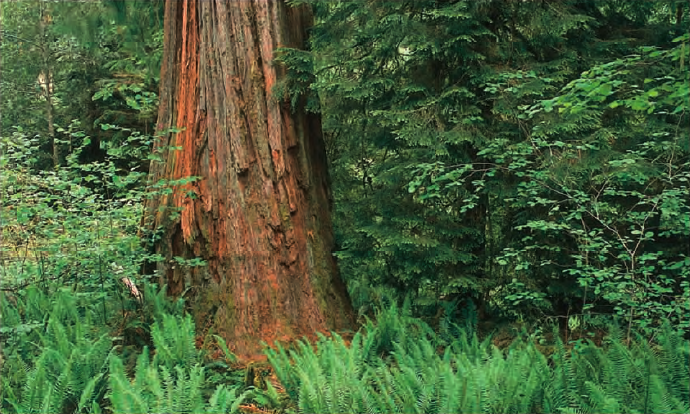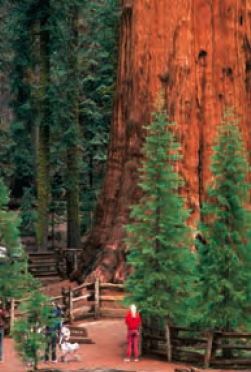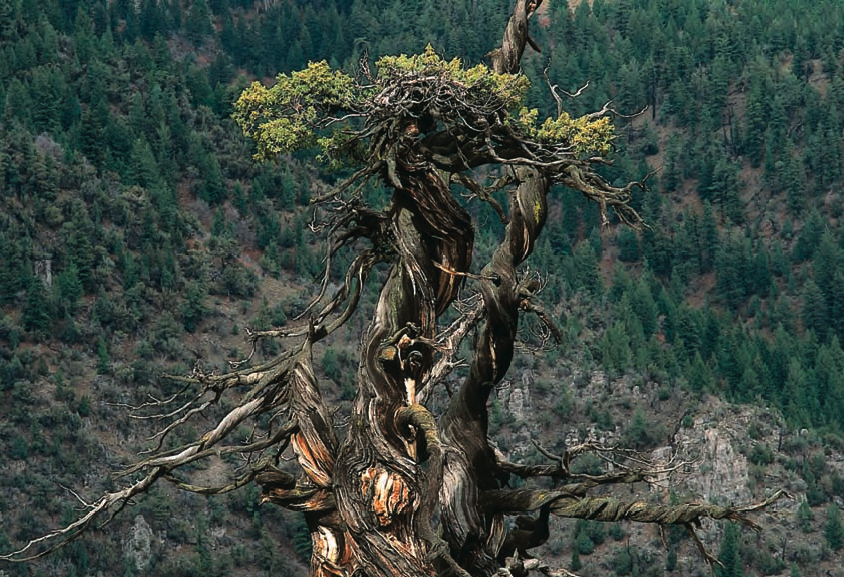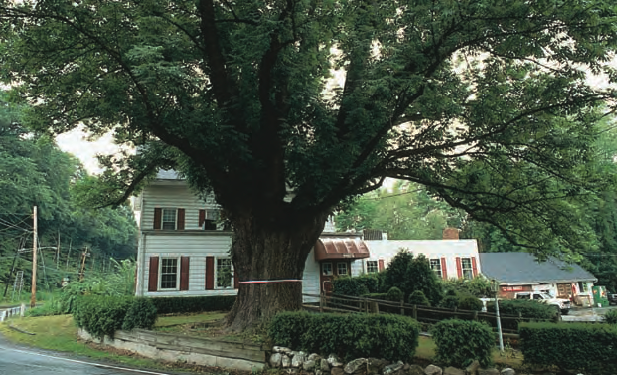Take a road trip to seek out the biggest trees in the nation!
Story and photos by Whit Bronaugh

In the process of seeking out some 200 national champion trees to photograph, write about, appreciate, and sometimes nominate, I have had my share of misadventures. I have searched for trees in the wrong places, chased the ghosts of those that had long died, found the tree only to discover that it had been misidentified or mis-measured, and been denied access to trees on private land. Once, in Alabama, I was frisked and nearly arrested when I was mistaken for some degenerate who had been threatening the locals and impersonating an officer (the landowner’s suspicions had been aroused when I requested to be met at the isolated locked gate of his property before dawn).
In this magazine, and in the National Register of Big Trees, we try to convey the wonder and beauty of big trees in prose, statistics, and photographs. But we all know that seeing and touching a big tree is a far better experience. Fortunately, you don’t have to be an expert big tree hunter, have the wilderness skills and acumen of Daniel Boone, own the tree itself, or go through the hassles I’ve been through to find and appreciate some of our finest big trees.
It’s true that most national champion trees are on private property or hidden deep within natural areas with no signposts and sometimes no trails. But many national champions can be seen from a road or are on public lands and easy to approach. Here then, is a guide for you to have your own experiences with 26 incredible trees that you can drive or hike to without much trouble. Enjoy!
PACIFIC NORTHWEST
Western Redcedar (931 points): Outside of California, the Quinault Lake Cedar is one of the biggest trees in the world, although it is quite hollow and above the ground living tissue is restricted to a two-foot-wide strip of bark that services one of the smaller upper trunks. From Highway 101 near the southwest corner of Olympic National Park, Washington, turn east onto North Shore Road (on the north side of Quinault Lake) and in about 4 miles look for the “Big Cedar Trail” sign near the Lake Quinault Resort. The half-mile trail to the tree involves a bit of uphill hiking.
Sitka Spruce (833 points): This giant, the country’s fourth largest champion, is on the property of Rain Forest Resort, but they graciously allow anyone to walk the ¼ mile level trail to the tree. It is a short drive from the champion Western Redcedar. From Highway 101 west of Olympic National Park in Washington, drive about three miles east on South Shore Road (south of Quinault Lake) to the Rain Forest Resort and the trailhead.
Bigleaf Maple (543 points): The nation’s biggest maple, and our third biggest broadleaf tree. You can easily find it just off the west side of Highway 103 about a block south of the intersection with Highway 202 and the tiny town of Jewell, which is about 50 miles northwest of Portland, Oregon.
Black Cottonwood (506 points): This tree grows along Mission Lake, an old channel of the Willamette River, in Willamette Mission State Park, 10 miles north of Salem, Oregon. It was dethroned in 2008 by a Washington tree just 9 point bigger but it will probably reign again because it has not been measured for over 25 years. You can reach it by walking on a level trail for about 100 yards. Ask at the visitor center for specifics.
Port-Orford-Cedar (773 points): The Elk Creek Champion is the sixth biggest champion in the country. To find it, drive 9.8 miles southeast of Powers on Elk Creek Road in the Siskiyou National Forest in southwestern Oregon. Contact the Powers Ranger District for further details.
CALIFORNIA

Giant Sequoia (1,321 points): If you love big trees, you must make a pilgrimage to the biggest tree in the world. In Sequoia National Park, every tree seems like a big tree. You can get to the biggest of them all, the 2,500-year-old General Sherman, via the Generals Highway, Wolverton Road, and a half mile hiking trail (gain and loss of 200 feet elevation). There is a short, wheelchair accessible trail from a separate parking lot right off the Generals Highway.
Joshua-tree (225 points): Joshua-trees are scattered throughout the mid elevations of the Mojave Desert, but the current champion grows in the cactus garden on the campus of Stanford University, east of Quarry Road and south of Arboretum Road. Two trunks grow from a low base, but only the bigger one was measured for champion status.
Western Juniper (573 points): This beautiful bonsai-shaped tree, called the Bennett Juniper, looks its multi-thousand-year-old age. Over half of the 13-mile one-way trip from Highway 108 in the Stanislaus National Forest in California’s Sierra Nevada is on unpaved, small roads. A vehicle with some clearance is nice, but if you go in August or September any car will do. For very detailed directions, visit www.savetheredwoods.org and click on ‘Protect’ and then ‘Juniper Project’.
California Fanpalm (Washingtonia) (212-217 points): There are three co-champions in the California State Capitol Park in Sacramento. One is the seventh tree north of the corner of N and 10th Streets on the northwest side of the park. Can you find the others? A tree guide and map is available at the Information Center in the Capitol Building.
Monterey Cypress (683 points): This is the ninth largest champion tree. It is on private property, but can be viewed from the road. From Highway 1 west of San Jose, California, drive east on Pescadero Road 4 miles past the tiny town of Pescadero. The tree will be next to the road on your left, its canopy spreading over the road.
California Sycamore (472 points): This tree grows along a road on state highway property in San Juan Capistrano, south of Los Angeles, California. From I-5 turn west at Exit 83 onto Junipero Serro Road. The tree is on the north side of the road about 100 yards west of the southbound exit ramp.
ROCKY MOUNTAINS

Rocky Mountain Juniper (331): You’ll need to be in shape for this one, but the 10-mile round trip hike, with a gain of 1,850 feet, and ending at 7,000 feet above sea level, is well worth the effort to see the Jardine Juniper. The gnarly, twisted, 1,500-year-old ancient is hanging on to life by a thread of cambium that feeds its tiny crown. From Logan, Utah, take US-89 east to the Woods Camp Campground on the left, 10 miles from the entrance to Logan Canyon. The trail starts at the parking area of the campground. A short spur from the loop at the end of the trail leads to a viewing platform for the tree.
Fremont Cottonwood (623 points): This is our biggest cottonwood, our fourth biggest broadleaf tree, and the 14th biggest champion. It is on private property, but you can see it from the road at milepost 17.5 on Highway 82 just west of the town of Patagonia in southeastern Arizona. There are places to pull off the road within about ¼ mile in either direction.
Arizona White Oak (268 points): This tree is only about an hour drive from the Fremont Cottonwood. From I-10 (southeast of Tucson), or Highway 82 (east of Patagonia), take Highway 83 south toward the Huachuca Mountains to the tiny town of Canelo. Now backtrack about 2/3 of a mile on 83 to a sharp left bend in the road. Shortly after the bend you will see the tree near the road on the south side.
MIDWEST AND NORTHEAST
Northern Pin Oak (279 points): This tree is easily found on the campus of the University of Wisconsin in Stevens Point, Wisconsin. It grows on Fremont Street at the southeast corner of the University Center building.
Yellow Birch (293 points): This champion is an old growth tree in Porcupine Mountains Wilderness State Park, located at the west end of the Upper Peninsula of Michigan. From the southwest end of the Presque Isle State Campground, hike through the woods 300 yards south-southwest to where, with a bit of skill or luck, you will find the tree on the southwest wide of a small gully. Or, you can find it the new fashioned way with a GPS: 46.70323 N, 89.98082 W.
Green Ash (397 points): The champion green ash grows next to a road north of Dowagiac in southeastern Michigan. From the intersection of M-152 (Dewey Lake Street) and M-51, drive west on M-152 for 3 miles. Turn left onto Townhall Road and drive one mile to the intersection with Topash Street where you will see the tree overhanging the road.

Rock Elm (350 points): This tree is only half an hour’s drive from the last stop (the Green Ash champion). After making your way to Dowagiac, Michigan, take M-62 southeast 9 miles to the town of Cassopolis. Stay on M-62 and drive south another 1.5 miles to Brownsville Road. Go east on Brownsville Road for 2.75 miles. The tree is on the north side of the road.
White Ash (420 points): This former champion was dethroned by the 10-year-rule, but may regain national champion status with new measurements. From the Palisades Interstate Parkway going north, take Exit 4 onto US-9W (left off the exit ramp), and go north 2.4 miles to veer left onto Highland Avenue. At the triangle junction in 0.1 miles keep right and you will see the tree immediately on your left in front of the Coppolas Tuscan Grill.
SOUTHEAST
Pumpkin Ash (307 points) and Swamp Chestnut Oak (435 points): Both of these trees are located in an 80-acre patch of remnant Mississippi River floodplain virgin forest protected in Big Oak Tree State Park in the extreme southeastern corner of Missouri. Here you get the bonus of two national champion trees. The Pumpkin Ash sign is posted on the boardwalk trail. Unfortunately, the Swamp Chestnut Oak received extensive damage from recent storms, but the impressive main trunk and one major limb survive.
Red Maple (405 points): This tree requires a bit of adventure, but is well worth the effort to experience a true, old growth red maple. In Great Smoky Mountains National Park, near the northeastern corner on the Tennessee side, take the Maddron Bald Trail south on the trail for 430 feet. Look to the west for a large tuliptree that leans away from the trail. From the tuliptree, follow a compass bearing of 257E for about 65 yards to a stand of old growth maples. The champion is obvious.
Live Oak (536 points): The Village Sentinel is currently our largest oak. It is the pride of the Baptist Village Retirement Community in Waycross, Georgia. Just drive up to the gate at 2650 Carswell Avenue on the west side of town, and tell the guard you want to see the big oak.
Eastern Redcedar (310 points): You’ve never seen an Eastern Redcedar like this one before. It dominates the cemetery of Lone Hill Methodist Church, 1428 Cross Road, just northeast of Douglas, Georgia (which is only 35 miles from the Live Oak). From Highway 32 in Douglas, go northeast on US-221 about 2.7 miles to turn left on Cross Road and go 1.1 miles to the cemetery on your left.
Gumbo-Limbo (237 points): Also called “tourist trees,” because they stand in the sun, turn red, and peel, the champion is located in De Soto National Memorial Park just north in Bradenton, Florida. From I-75 take Exit 220 and go west on State Road 64 for 12 miles to a right (north) onto 75th Street West, which dead-ends at the park in 2.5 miles. The tree is right in front of the visitor center.
Florida Strangler Fig (485 points): Strangler fig seeds are deposited on some other tree, like a fanpalm, by birds. The seed sprouts and grows long aerial roots that eventually reach the ground. Eventually it may engulf the host tree, which usually dies and rots away, and then develop its own intricate trunk. This tree is located in the Bill Sadowski Park at 17555 SW 79th Street, Miami, Florida. Take a 10-minute walk through a beautiful example of a pristine hardwood hammock to the canal at the end of the nature trail, where you will find the tree on the left.
Whit Bronaugh hails from Eugene, Oregon.
This article was published in the Summer 2009 issue of American Forests magazine.